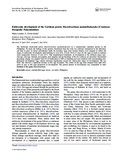Embryonic development of the Caridean prawn Macrobrachium mammillodactylus (Crustacea: Decapoda: Palaemonidae)
Share
Abstract
The freshwater knob-tooth prawn Macrobrachium mammillodactylus is a commercially exploited species in the Philippines. To study the biology of this species, broodstock from the wild was collected, transported to the laboratory and kept in pairs in indoor polyethylene tanks for breeding. Eggs from berried females were sampled to follow the stages of embryonic development until hatching to zoea larva. It took 18.0 ± 2.1 days for the eggs to hatch at ambient water temperature between 25 and 28 °C. The morphological landmarks of development at the different stages (pre-cleavage, cleavage, blastula, pre-nauplius, post-nauplius and pre-hatching) of the live embryos are described. Incremental percentage staging was adopted from 0% at fertilization to 100% at hatching and were matched with corresponding morphological development. Egg volume increased significantly toward the mid-to-later stages of development. The eye index also showed a significant increase as the egg developed. The colour of the egg mass changed from light olive green to grey as the eggs progressed in development. The general pattern of development was comparable to other members of the genus Macrobrachium.
Suggested Citation
Cuvin-Aralar, M. L. A. (2014). Embryonic development of the Caridean prawn Macrobrachium mammillodactylus (Crustacea: Decapoda: Palaemonidae). Invertebrate Reproduction and Development , 58(4), 306-313. https://doi.org/10.1080/07924259.2014.944674
Subject
Taxonomic term
Collections
- AQD Journal Articles [1249]

